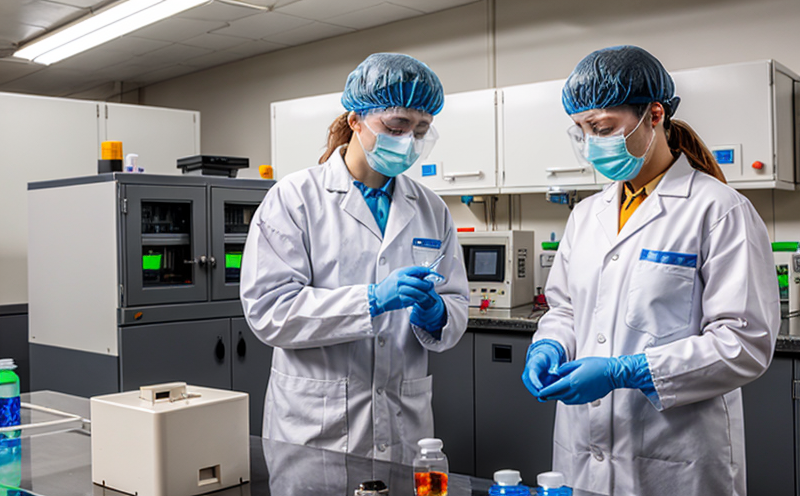EN 17289 3-MCPD Detection in Bakery Ingredients
The European standard EN 17289:2015 provides a method for determining the levels of 3-monochloropropane-1,2-diol (3-MCPD) esters in bakery ingredients and products. This analysis is crucial given that high concentrations of 3-MCPD can lead to potential health risks. In this service, we use state-of-the-art equipment and follow a stringent procedure to ensure accurate detection.
Our laboratory adheres strictly to the provisions outlined in EN 17289:2015 for the extraction process. The extracted samples are then analyzed using High Performance Liquid Chromatography with Tandem Mass Spectrometry (HPLC-MS/MS). This method ensures precision and reliability, providing results that meet international standards.
Bakery ingredients often undergo various stages of processing before reaching consumers. During these processes, heat can generate compounds like 3-MCPD esters which are undesirable in food products. By detecting these contaminants at early stages, we help our clients maintain product quality and compliance with regulatory requirements.
The importance of this test cannot be overstated. It ensures that the end-product is safe for consumption while also protecting brand reputation. Regulatory bodies such as the European Food Safety Authority (EFSA) recommend monitoring 3-MCPD levels in foodstuffs to prevent adverse health effects.
Our team is well-versed in handling diverse samples ranging from wheat flour to semolina. We provide comprehensive reports detailing the findings, helping you make informed decisions about ingredient sourcing and processing methods. Regular testing not only ensures compliance but also contributes towards maintaining high standards of food safety.
| Sample Type | Description | Extraction Method | Analysis Technique |
|---|---|---|---|
| Bakery Flour | Fine powder used in bread making | Solid-Phase Extraction (SPE) | HPLC-MS/MS |
| Milled Semolina | Pasta flour made from durum wheat | Solvent Extraction | HPLC-MS/MS |
With our expertise and advanced technology, we offer reliable 3-MCPD testing services tailored to your specific needs. Whether you're a small bakery looking for quality assurance or an international company ensuring product consistency across different markets, our service is designed to meet your requirements.
In addition to detecting 3-MCPD esters, this test also helps identify other potentially harmful compounds that may form during baking processes. Our rigorous testing protocols ensure accurate identification and quantification of these contaminants, enabling you to take proactive measures against contamination risks.
Applied Standards
The European standard EN 17289:2015 specifies the procedure for determining the levels of 3-monochloropropane-1,2-diol (3-MCPD) esters in bakery ingredients and products. This standard is particularly relevant when dealing with heat-exposed food items where 3-MCPD formation might occur.
The standard defines clear guidelines on sample preparation, extraction techniques, and analytical methods to be used during the testing process. It emphasizes the importance of accurate quantification of 3-MCPD esters in order to comply with relevant regulations set by health authorities.
By adhering strictly to these standards, we ensure that our results are both consistent and reliable across different batches and production runs. Compliance with EN 17289 helps maintain product integrity throughout the supply chain, ensuring that consumers receive safe and high-quality food products.
Scope and Methodology
The scope of this service includes detecting 3-MCPD esters in bakery ingredients such as wheat flour, semolina, and other grain-based products. The methodology involves several key steps:
Sample Collection: Properly collecting representative samples is critical to obtaining accurate results.
Extraction: Using solid-phase extraction (SPE) or solvent extraction techniques based on the sample type.
Cleanup: Removing interfering substances from the extracts to improve analytical sensitivity.
Analysis: Employing HPLC-MS/MS for precise quantification of 3-MCPD esters.
The process is designed to be robust, ensuring consistent and repeatable results. Our team follows all prescribed steps meticulously, adhering strictly to the provisions outlined in EN 17289:2015.
| Sample Preparation | Extraction Technique | Cleanup Procedure | Analytical Method |
|---|---|---|---|
| Wheat Flour | Solid-Phase Extraction (SPE) | Clean-up using silica cartridges | HPLC-MS/MS |
| Milled Semolina | Solvent Extraction | Dilution with acetonitrile | HPLC-MS/MS |
This approach guarantees that every sample is handled correctly, reducing the risk of errors and ensuring accurate results.
Why Choose This Test
Ensures compliance with international standards like EN 17289:2015.
Promotes safer food products by identifying potentially harmful contaminants early in the production process.
Helps maintain product quality and reputation among consumers.
Facilitates better decision-making regarding ingredient selection and processing methods.
Supports regulatory compliance requirements for food safety.
Provides comprehensive reports detailing test results, aiding in informed decision-making processes.
Selecting this service ensures that your bakery ingredients meet stringent quality standards. By choosing our laboratory, you invest in a safer and more reliable product line, fostering trust with customers and regulatory bodies alike.





